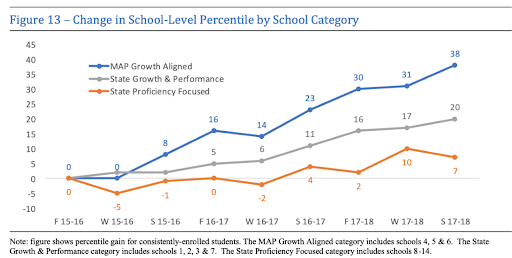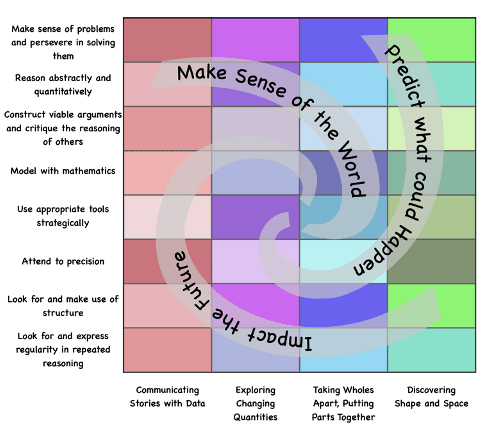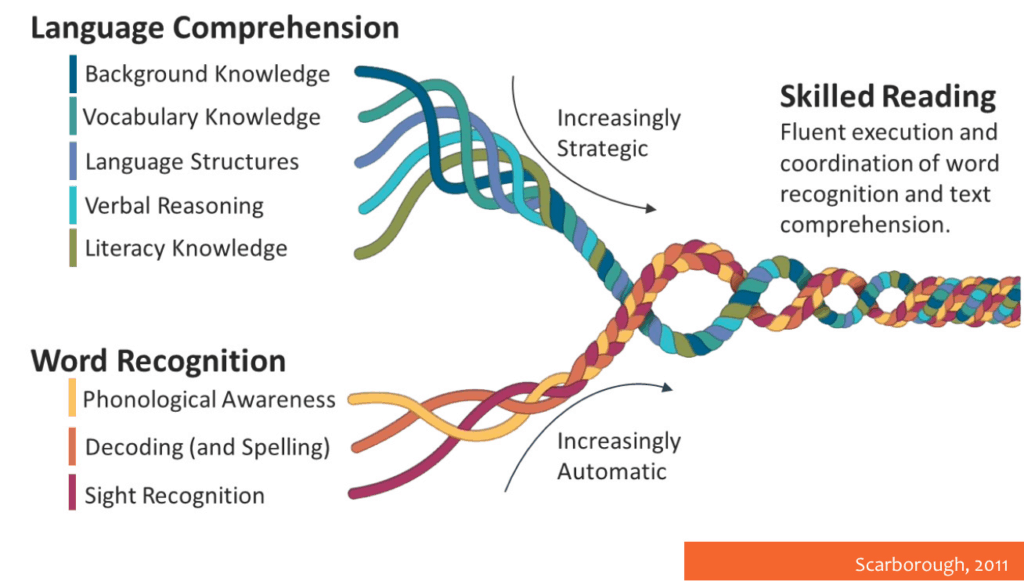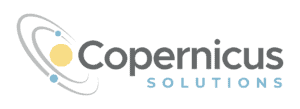FOCUSING ON KEY CONTENT
Driving Question: How can we effectively support all students to accelerate their
mathematics, language, and foundational reading knowledge and skills?
WHY
A key component of effective learning acceleration is knowing what content to focus on and when. When students have unfinished learning , remediation ( repetition) of previous content, or focusing only on grade-level content, often leaves students further behind. Instructional time is limited and it can be challenging for teachers to address each student’s unfinished learning while also covering the grade-level material—all in a single school year. Successful learning acceleration requires teachers to understand the content in different ways–to focus on big ideas, content connections, and learning progressions–so they can pinpoint exactly what students will need to progress, create logical and efficient learning sequences, and weave in necessary practice with missing skills as they go.

This section of the PAL will offer
- A brief overview of the research on why focusing on grade-level standards alone is not enough
- Key ideas for focusing on content in ways that align with learning acceleration best practices
- Specific strategies for identifying key mathematics, ELA, and foundational reading content
- Curated tips for planning for meaningful work
- Links to additional resources for your review
We Need More Than Grade-Level Standards
The amount of instructional time teachers have with students over the course of a school year is limited, so we need to know how to make the best use of that time. We know that teaching only to the grade-level standards or only focusing on remediating missed skills can leave students further behind and exacerbate inequity. Let’s look at an example:
In the Iceberg Problem, the authors look at the layers of unfinished learning many students have in mathematics and the impact of different instructional approaches on students’ learning growth. They used an individualized math program they had developed that operates in many schools to study the outcomes associated with whether teachers were required to teach only to grade-level standards or whether they could meet students where they are, based on diagnostic tests.
In the first group of schools, teachers were required by their districts to teach to the grade-level standards around the state proficiency benchmarks. In the second group, teachers were allowed to meet the students where they were–teaching below grade level skills as required to meet them in the zone of proximal development and moving them forward purposefully while closing gaps in their knowledge. The grade-level standards-only group gained 7 percentile points over 3 years. The diagnostic-focused group gained 38 percentile points over 3 years.
When teachers know enough about their content–the big ideas, where concepts intersect and overlap across standards, and how student learning progresses over time around those core ideas, it is much easier to create targeted learning plans for students.
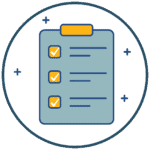
Key Ideas for Focusing on Content
- Focus on the big ideas and content connections. This will help create clarity, coherence, and rigor that is grade-level appropriate. (See curated tips below for more details)
- Use learning progressions to pinpoint where students are on their learning journey. Learning progressions show a developmental continuum for each content strand. They allow the teacher to answer the question, “If my student is here, what is the next thing they need to learn?” While they do not yet exist for California standards, the Center for Assessment has developed a set for K-12 mathematics as well as tools and strategies for developing and using learning progressions that might be useful.
- Strong core materials and teacher support are key. Supporting unfinished learning requires a strong core curriculum and intensive planning support for teachers for each unit of study. Visit CCEE’s Fieldguide for Learning, Equity and Well-Being to find more information on creating a learning culture, or the Iteration and Support section of this playbook for more information.
- Plan meaningful work. It’s not useful to go back and reteach units students may have missed. Instead, focus on the big ideas–those concepts that often cross grade levels–to help move students from where they are to where they need to be.
- Employ culturally responsive instructional strategies to create equitable and meaningful instruction.
- Use frequent standards-aligned formative assessments to drive instructional decisions.
- Invest in reading. Provide students regular and intentional opportunities to grow their literacy skills in all subject areas.
- Pay special attention to foundational reading skills. Supporting unfinished learning in foundational reading skills is quite different from supporting unfinished learning in math and science. Acceleration in reading requires clarity about the systematic progression of learning; precise diagnostics about whether students are behind and where they are in the progression of learning; and small-group structures that target the particular next step each child needs.
- Limit pull-out time to foundational reading. Use pull-outs for foundational reading instruction but not for learning acceleration in core content areas, as it is not effective there.
Curated Tips For Mathematics
- Focus on the big ideas. A “big idea” approach has been shown to engage students and increase achievement because it feels more coherent, connected, and meaningful. Organize work around the four content connections (shown on the X-axis of the graphic), the 8 big ideas (shown, on the Y-axis of the graphic), and the three cross-cutting themes (shown in the swirls) that represent the major work of mathematics instruction in the California Mathematics Framework.
- You don’t have to do it all. Quality math instruction isn’t a mile wide and an inch deep. Instead, it follows the big idea approach by selecting high-leverage standards in each grade to focus on content that students need to know. The California Digital Learning Integration and Standards Guidance: Section B— Standards Guidance for Mathematics has identified a set of these standards. By focusing on these standards, you will also address other interrelated and overlapping standards (see Grade 7 constellation map as an example).
- Use learning progressions to help. As evidenced by the Iceberg Problem Study, teaching the mathematical grade-level standards without adequate differentiation holds many students back considerably or causes them to fall further behind. When teachers instead use learning progressions like these that provide teachers with a developmental continuum for content big ideas along with regular diagnostic assessments, students made almost three times the gains as those who focused only on grade-level standards.
- Focus on meaning-making. Give students many opportunities to understand how mathematics works and why. Create regular experiences for students to explore mathematical concepts on their own and with each other, explain their thinking, and develop their stamina as sense-makers. A focus on meaning-making helps the ideas stick and allows them to persevere through more challenging endeavors.
- Provide multiple ways to interact with and represent mathematical concepts. Use manipulatives (physical and digital), videos, pictures, simulations, and graphic organizers to support students in making sense of concepts and showing what they know about how mathematics works. This works well for all students but is particularly important for English learners and students with special needs.
- Create a shared understanding. Ensure all students can interact with, learn from, and contribute to a shared mathematical understanding within their classroom community. By engaging in authentic problem-solving, doing meaningful tasks, and collaborating with peers, students can see themselves as mathematicians and persevere through rigorous tasks. To learn more, visit Equitable Math Instruction.
ADDITIONAL RESOURCES
- Updated Mathematics Framework for California Public Schools: K-12
- California Digital Learning Integration and Standards Guidance Excerpt: Section B— Standards Guidance for Mathematics (pages 101–212)
- CCEE Field Guide resources for Accelerating Learning (ELA, math, science)
- Math fluency inventories by the National Council of Teachers of Mathematics
Curated Tips for ELA
- Focus on the big ideas. A “big idea” approach has been shown to engage students and increase achievement because it feels more coherent, connected, and meaningful. Organize your work around the five big ideas or themes that represent the major work of ELA/literacy instruction in the California Common Core State Standards for English: making meaning, language development, effective expression, content knowledge, and foundational skills (see graphic to right).
- You don’t have to do it all. Use the key standards indicated in each grade and the related standards to focus on content that students need to know. These standards have already been identified in the California Digital Learning Integration and Standards Guidance: Section C— Standards Guidance for English Language Arts, Literacy, and English Language Development (pages 212–486). By focusing on these standards, you will also address other interrelated and overlapping standards (see chart below for an example).
- Remember that literacy happens in other content areas, too. Collaborate across content areas such as history/social studies, technical subjects, and science to help students continue to grow their literacy skills in content-embedded ways.
- Offer students opportunities to access grade-level text. Evidence indicates that having struggling readers read texts below-grade day after day does not help them “catch up” (Iceberg Report). While students need explicit instruction in foundational reading skills (K-2), once they have developed basic decoding skills, teachers should use more guided reading time, working in grade-level text with appropriate scaffolding and knowledge-building to help students be successful.
- Create learning that is equitable and culturally relevant. Ensure that the texts and topics you use reflect and positively affirm the lives, languages, perspectives, and histories of all students, including historically marginalized populations. Use positively affirmed texts to ensure students see themselves and their experiences in text. You can audit your classroom library to ensure that texts and topics represent many diverse perspectives and identities and that curriculum is culturally relevant. Consider these additional ways to bring more equity to literacy instruction.
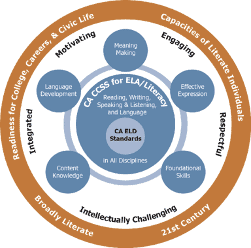

ADDITIONAL RESOURCES
- California Digital Learning Integration and Standards Guidance Excerpt: Section C— Standards Guidance for English Language Arts, Literacy, and English Language Development (pages 212–486)
- Video for ELA/ELD Standards Guidance
- Download ELA/ELD Standards Guidance webinar slides
- Specific strategies for grades and subjects in CCEE’s Field Guide
- CCEE Field Guide resources for Equity, Learning and Well-Being (ELA, math, science)
Curated Tips for Foundational Reading
- Scope and sequence matter. Early reading skills are meant to be taught sequentially. Use learning progressions such as these to develop a research-based instructional trajectory
- In foundational reading, it’s okay to go back and remediate. If students missed parts of reading foundations, it is appropriate to go back and teach the skills (including print concepts, phonological awareness, phonics, and fluency) beginning where they left off.
- Plan for brief screeners. Administer a brief screener at the beginning of the year and at periodic checkpoints throughout the school year. Prioritize letter inventory, phonological awareness, and grade-level appropriate sound and spelling patterns for each student.
- Ensure daily, systematic phonics instruction. Ensure at least 45 minutes a day of foundational skills work through direct instruction and related practice opportunities, and additional support for students who need more.
- Support decoding and fluency development. Support students’ decoding and fluency development through additional small-group or individual support; through opportunities to amplify or embed practice with needed skills within existing instruction or practice opportunities; through modified student practice or scaffolds.
- Make language connections for English language learners. Make connections between English and your student’s home language(s) so that you can leverage each child’s existing knowledge and skills. Here are additional tips to address the needs of English Language Learners
- Tailor instruction for students with disabilities. Here is a resource on reading for students with disabilities, and here is one for students with reading disabilities.
- Keep the text at the center of your planning. Plan standards-aligned questions, tasks, and activities that help students unpack the ideas of assigned texts while drawing on their own funds of knowledge and many skills, strategies, and modes of co-constructing meaning. Here’s a resource: CDE: New Research on Text Complexity
- Use complex books for read-aloud. Select books for read-aloud that are far more complex than students can read on their own (1–3 years above what most students can read independently). For guidance in choosing books, consider the following: Measuring Text Complexity
- Offer choice and variety. Use choice-based, topical text sets and book baskets for independent reading and use small-group time to secure foundational skills or grow knowledge and vocabulary with topically connected, on-level text sets. For more, consult the following:
ADDITIONAL RESOURCES
Curated Tips to Plan for Meaningful Work
- Remember to build on prior knowledge. A crucial aspect of acceleration is building on prior knowledge so students can connect with new information. “Students learn faster and comprehend at a higher level when they have prior knowledge of a given concept” (Marzano, 2004).
- Teach background knowledge and vocabulary. Students’ comprehension of relevant background knowledge and vocabulary is key to understanding what they read. By using text sets, a variety of resources to focus on the topic (including multimedia resources, photographs, recordings, infographics, and other texts), teachers can build this understanding.
- Take a mastery learning approach. Students need to engage in high-quality work tailored to their zone of proximal development, get feedback, and have time to try again and improve. This way of working is meaningful for students because it builds ownership, confidence, and a sense of control over their own learning. Students who say they know how to improve are more likely to persist in the hard work of learning acceleration.
- Prioritize active learning over teacher talk time. Give students more opportunities to engage. Moving away from long lectures is one of the best ways to get students to learn and to allow teachers to understand the gaps that need to be filled.
- Leverage technology strategically. Technology allows for enhanced personalization and engagement for students and can create more supportive and equitable learning cultures in schools and districts. Blended learning allows teachers more time to strategically accelerate learning by filling gaps and building bridges in student learning. Find out more about leveraging technology here.
- Use a vetted curriculum. Curriculum should not be made from scratch. Rather, use existing high-quality curriculum aligned with instructional goals, learning progressions and diagnosed student need. Then, modify and/or supplement when necessary.`
- Offer students opportunities for personalization. The experiences of innovative school districts across the country point to increased success when learning is personalized to individual needs, interests, and goals. Creating these types of experiences requires educators to know how to blend and personalize learning.
- Provide playlists of ways students can practice just-right learning concepts without taking time away from grade-level instruction
- Use a rotational model to work with small groups (both heterogeneous and homogeneous). Station rotation models that include teacher time and independent work time can create opportunities to address misconceptions. Small-group instruction is an effective way to remediate in real-time for students who need support. “Just-in-time support” helps students feel successful and allows them to understand grade-level content.
- Teach students to work independently. And practice this often. Have clear strategies in place for defining expectations and success. A clear pathway will make execution easier and contribute to students’ development of self-direction skills.
Curated Tips: Let Assessment Drive Instruction
- Know what kids know. Uncovering and addressing learning needs will require teachers to know what students know and can do throughout the school year. This means assessing their knowledge and skills daily or weekly, not just on unit or quarterly benchmarks or standardized assessments.
- Assess what students need. Assess what students need socially and emotionally as well as academically, address trauma with healing and support, and identify the next steps they are ready to take in their learning rather than labeling them. For more, you can also consult CCEE’s Field Guide for Accelerating Learning, Equity and Well-Being.
- Let assessment guide your planning. Use the standards continuums in the California Mathematics Framework and the California Common Core State Standards for English to assess where students are on their learning journeys and to plan instruction that will take students from where they are to where they need to be. Even if students are missing knowledge or skills from a previous grade, a focus on the content connections, big ideas, and cross-cutting themes means students can continue to develop their knowledge while working on grade-appropriate standards.
- Focus on formative assessment. Ensure frequent formative assessments are included in daily lesson plans and drive instructional planning. Entrance and exit tickets, 1-to-1 conferences, written and oral explanations, reading fluency checks, quizzes, classwork, homework, and digital tools (such as polling or assessments embedded in tools like PearDeck or NearPod) all can provide plenty of information for teachers to determine students’ current levels of performance and make data-driven instructional decisions. Recommendations for these practices should be informed by high-quality instructional materials.
- Be flexible. Use assessment to determine flexible groupings for just-in-time interventions to prepare all students for daily grade-level instruction. These assessments should reveal what students already understand and what further connections might be necessary for them to fully access grade-level content. These assessments should not lead to the labeling and sorting of children, which often leads to segregation, marginalization, or privileging in ways strongly correlated with race, language, class, and ability status.
- Be strategic with remediation. If students need extra support, remediation should be brief and embedded within grade-level instruction as much as possible. Small-group instruction, tutoring, and other strategic and targeted supports are recommended when needed to develop appropriate background knowledge or skills. Avoid removing students from general grade-level instruction or tracking students when at all possible, as this leads to further inequity.
FEATURED RESOURCES:
- Center for Assessment K-12 Mathematics Learning Progressions
- CDE Video: Digital Learning Integration and Standards Guidance for English Language Arts and English Language Development (ELA/ELD)
- CCEE Field Guide: Specific strategies for grades and subjects
- CCEE Field Guide: Resources for Equity, Learning and Well-Being (ELA, math, science)


